Students can Download Chapter 11 Transportation in Animals and Plants Questions and Answers, Notes Pdf, KSEEB Solutions for Class 7 Science, Karnataka State Board Solutions help you to revise complete Syllabus and score more marks in your examinations.
Karnataka State Syllabus Class 7 Science Chapter 11 Transportation in Animals and Plants
Class 7 Science Transportation in Animals and Plants NCERT Textbook Questions and Answers
Question 1.
Match structures given in Column I with functions given in Column II.
| Column I | Column II |
| (i) Stomata | (a) Absorption of water |
| (ii) Xylem | (b) Transpiration |
| (iii) Root hairs | (c) Transport of food |
| (iv) Phloem | (d) Transport of water |
| (e) Synthesis of carbohydrates |
Answer:
i – b,
ii – d,
iii – a,
iv – c
Question 2.
Fill in the blanks.
- The blood from the heart is transported to all parts of the body by the ______________.
- Hemoglobin is present in ______________ cells.
- Arteries and veins are joined by a network of ______________.
- The rhythmic expansion and contraction of the heart is called ______________.
- The main excretory product in human beings is ______________.
- Sweat contains water and ______________.
- Kidneys eliminate the waste materials in the liquid form called ______________.
- Water reaches great heights in the trees because of the suction pull caused by ______________.
Answer:
- arteries
- red blood cells
- capillaries
- heartbeat
- urea
- salts
- wine
- transpiration
Question 3.
Choose the correct options:
(a) In plants, water is transported through
(i) Xylem
(ii) Phloem
(iii) Stomata
(iv) Root hair
Answer:
(i) Xylem
(b) Water absorption through roots can be increased by keeping the plants
(i) in the shade
(ii) in dim light
(iii) under the fan
(iv) covered with a polythene bag
Answer:
(iii) under the fan
Question 4.
Why is the transport of materials necessary in a plant or in an animal? Explain.
Answer:
The cells of different organs of plants and animals need various necessary substances to carry out many metabolic activities and different types of waste products are created during these metabolic activities. So, the transport of materials is necessary to supply the required substances and to remove the waste products.
Question 5.
What will happen if there are no platelets in the blood?
Answer:
If there are no platelets in the blood, then the blood would not be able to clot. A clot is formed because of platelets. They release blood-clotting chemicals at the site of injury. These chemicals form a clot and prevent further bleeding.
Question 6.
What are stomata? Give two functions of stomata.
Answer:
The numerous pores under the surface of leaf are called stomata.
Functions of stomata :
a. Stomata help in the exchange of gases.
b. Evaporation of water from the leaf surface occurs through stomata.
Question 7.
Does transpiration serve any useful function in the plants? Explain.
Answer:
Transpiration is the evaporation of water from the plants. The water evaporates through the stomata present on the surface of the leaves. It is called a necessary evil because.
- It helps in lowering the temperature of the plant thus prevents heat injury to the plant.
- Due to transpirational pull water rises in higher plants. ,
- It also causes loss of water absorbed by plants.
Question 8.
What are the components of blood?
Answer:
The main components of blood are :
a) Red blood cells (RBCs)Red blood cells are the most abundant cells in the blood these cells contain a red pigment called hemoglobin. It is the hemoglobin which carries oxygen and transports it to all parts of the body.
b) White blood cells (WBCs): These cells can change their shape and help the body in fighting against diseases thus, they constitute the immune system of the body.
c) Platelets: they help in blood clot formation thus prevents excessive bleeding from wounds.
d) Plasma: All the blood cells are present in plasma. It also contains dissolved nutrients.
Question 9.
Why is blood needed by all the parts of a body?
Answer:
Blood is needed by all parts of the body as it is an important part of the transport system of our body. It performs the following important functions :
- It transports O2 from the lungs to all the body cells.
- It carries CO2, a waste product back to the lungs, so that it can be exhaled easily.
- It transmits heat, thus regulating the body temperature.
- It also fights off diseases and infections.
Question 10.
What makes the blood look red?
Answer:
The presence of hemoglobin, a red pigment in the red blood cells (RBC’s) makes blood appear red in colour. The hemoglobin carries oxygen and transports it to all the parts of the body.
Question 11.
Describe the function of the heart.
Answer:
The human heart is divided into four chambers. The upper two chambers are called the right and left atrium and the. lower two chamber are called the right and left ventricles, right atrium receives carbon dioxide-rich blood from the body. Blood from right atrium enters the right ventricle, which contracts and pumps the blood to the lungs.
On the other hand, oxygen rich blood from the
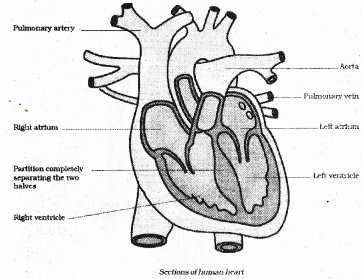
lungs returns to the left atrium, from the left atrium, blood enters left ventricle. Left ventricle contracts and pumps the blood to all parts of the body. Hence, the rhythmic contraction and expansion of various chambers of the heart maintains the transport of oxygen to all parts of the body.
Question 12.
Why is it necessary to excrete waste products?
Answer:
All cells of our body produce waste products. These waste products are toxic to the body and therefore need to be executed out. This process of removing waste products produced in the cells of living organisms is called excretion.
Question 13.
Draw a diagram of the human excretory system and label the various parts.
Answer:
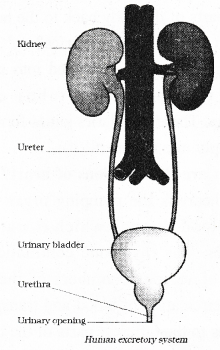
Class 7 Science Transportation in Animals and Plants Additional Important Questions and Answers
Question 1.
What is blood? What is its function?
Answer:
Blood is a liquid Connective tissue. It is the circulatory fluid. Its important functions are:
- It transports substances like digested food from the small intestine to other parts of the body.
- It carries oxygen from the lungs to the cells of the body.
- It transports waste for removal from the body.
Question 2.
Define Circulatory’ System.
Answer:
Heart and blood vessels together form the circulatory System. Its main function is to transport the materials.
Question 3.
What are the Components of blood, state its function.
Answer:
Blood Consists of Plasma (fluid) RBC, WBC and Platelets. Plasma is a liquid mainly contains Water. RBC means red blood cells which contains Haemoglobin a red pigment which gives red colour to blood and binds with oxygen and transports it to all parts of the body cells. WBC means white blood cells which fight against germs that may enter our body
Platelets are the types of cells present in the blood which help in clotting of blood.
Question 4.
How many types of blood vessels in human body? Name them and state its function.
Answer:
There are two types of blood vessels in human body. They are arteries and Veins. Arteries carry oxygen-rich blood from the heart to all parts of the body. Veins are thieves- sels which carry carbon dioxide-rich blood from all parts of the body back to the heart.
Question 5.
What are blood Capillaries?
Answer:
Arteries are further divided into smaller vessels extremely thin tubes called Capillaries. These Capillaries join to form veins which empty into the heart.
Question 6.
What are the functions of the heart?
Answer:
The heart is the pumping organ which pumps blood through which it transport substances. The rhythemic contraction and relaxation of various chambers of the heart maintain circulation of blood and transport of substances to the different parts of the body.
Question 7.
What is the pulse?
Answer:
Pulse is the throbbing due to the blood flowing in the arteries.
Question 8.
Define pulse rate.
Answer:
The number of heartbeats per minute is called the pulse rate.
Question 9.
Define the excretion and excretory system.
Answer:
The process of removal of wastes produced in the cells of the living organisms is called excretion. The parts involved in excretion from the excretory system.
Question 10.
What is dialysis?
Answer:
Dialysis is an artificial process of filtering the impure blood periodically in case of a person’s kidney failure.
Question 11.
Draw a neat diagram of the circulatory system of man. Label the parts.
Answer:
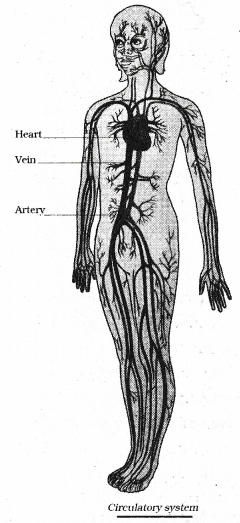
Question 12.
Draw a neat diagram of sections of human heart.
Answer:
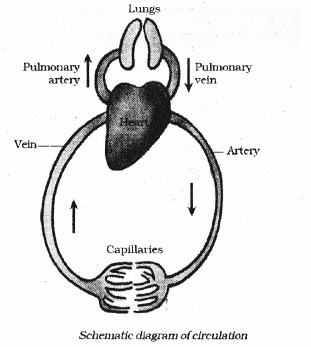
Question 13.
Draw a neat diagram of sections of human heart ?
Answer:
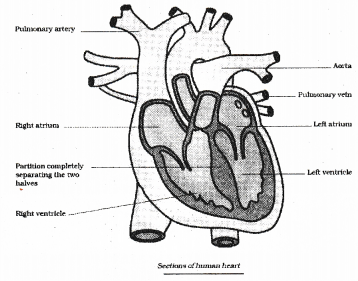
Question 14.
What are the waste products contained in urine and how much urine produced in one day by an adult?
Answer:
An adult human being normally passes about 1 to 18 litres of urine in one day. The urine consists of 95% water 2.5% urea and 2.5% other waste product.
II. Fill in the blanks :
- William Harvey discovered the circulation of blood.
- The artificial process of removing the waste products in the blood is called dialysis.
- A tissue is a group of cells that perform specialised functions in an organism.
- The water-conducting tissue in plant is Xylem.
- The food conducting tissue in plant is Phloem.
- Main excretory organ in human is Kidney.
- The excretory substance in fish is Ammonia.
- Blood Platelets help in blood clotting
- 9. The main circulatory fluid in man is blood.
- A stethoscope is an instrument to hear the heartbeat.
III. Match the following
| A | B |
| 1. Haemoglobin | a. Which fight against germs. |
| 2. W.B.C | b. red blood cells |
| 3. R.B.C | c. two upper chambers of heart. , |
| 4. Atria | d. two lower chambers of heart. |
| 5. Ventricles | e. helps to avoid mixing up of blood. |
| 6. Partition between the Chambers | f. binds with oxygen. |
| 7. Urine stored | g. birds, snakes, lizards. |
| 8. Root hair | h. in the urinary bladder. |
| 9. Sweat | i. absorb water. |
| 10. Uric acid | j. water and salts. |
Answers :
1 – f,
2 – a,
3 – b,
4 – c,
5 – d,
6 – e,
7 – h,
8 – i,
9 – j,
10 – g